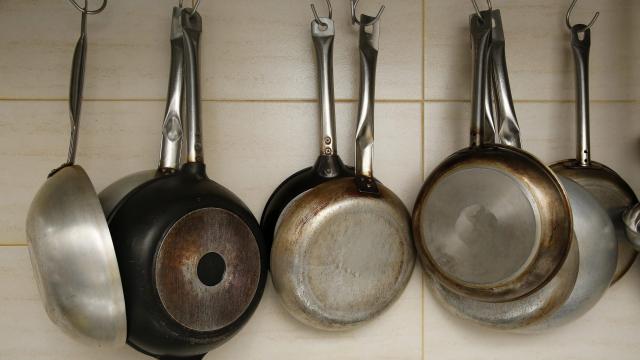Pots and pans can have a pretty long shelf life, depending on their style, brand, and how well you take care of them — but odds are you’re stretching that lifespan a little too long. The signs that your cookware is at the end of its life aren’t always as obvious as a broken handle or peeling finish. Although there are several ways to restore your cookware to an almost new condition, sometimes it’s beyond repair. Here are a few signs that your pots and pans are officially on the outs.
How to best care for different types of cookware
The average life of your stovetop cookware is five years, according to cooking site The Kitchn, and there are ways to care for your pots so they last at least that long, if not longer. To start with, you should wash any nonstick pans by hand; the dishwasher heat causes nonstick coatings to thin and deteriorate much more quickly than hand-washing will. Likewise, avoid using metal utensils when cooking in nonstick pans, as they scratch the coating more easily than wood or plastic utensils.
For stainless steel cookware, Kelly Vaughan at MarthaStewart.com advises, first and foremost, to use the right amount of oil while you cook. Covering the bottom of your pan in oil or fat gives it enough lubricant to both cook your meal and protect the pan. Vaughan also suggests moving the food around as much as possible to avoid burning the food to the pan.
Cast iron skillets will vastly outlast your stainless steel and nonstick pans — as long as you are seasoning them properly. The number one rule of cast iron cookware is not to use soap or any cleaning products that will harm the enamel and natural coating — but this guide will help you with all the rest.
How to tell if your nonstick pan is beyond repair
The signs of a useless nonstick pan are pretty straightforward: If the coating is scratched, your food will stick to the pan, and it will burn (and cause further damage to the pan). Once you can see the layer below that original non-stick layer, she’s outlived her usefulness, and it’s time for a new one.
How to tell if your stainless steel pan is no longer useful
Signs that your stainless steel cookware is ready to be tossed are more subtle than other pans. If you put the pan on the stove and it wobbles, the structure has been warped, and it will no longer cook your food evenly. (Warping is often caused by running cold water over or in a hot pan right after use, so let it cool down before you clean it.)
Another sign of a stainless steel pot’s demise is burn spots. If certain areas of the pan tend to burn food every time you use, that means the stainless steel coating has deteriorated, and it’s time to spring for a new one.
Signs that your cast iron skillet needs to go
Cast iron cookware is often much-beloved and can even be passed down from generation to generation — if they’re properly cared for. But sometimes, they’re simply beyond repair. Like any other pan, if it wobbles on the stovetop, it has been warped and is beyond repair. Another sign that it’s too far gone is the enamel on the skillet has chipped, you may notice food is not cooking evenly, and rust may even appear.
Finally, and perhaps most importantly, when you see cracks in the pan, it is no longer safe to use. As cooking site Taste of Home explains: “ [e]ven a hairline crack will expand and contract when heated and cooled, and ultimately the pan will split — a potentially dangerous situation if it happens during cooking!” In case that’s not motivation enough to ditch it, cracks are also tricky to clean, making them magnets for bacteria and buildup.

Leave a Reply
You must be logged in to post a comment.